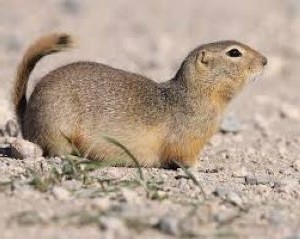Are ground squirrels wreaking havoc in your yard?
Don’t worry, we have got you covered!
Ground squirrels can damage everything in your yard, including trees, flowers, fruits, and vegetables. They are troublesome pests that home gardeners find tough to get rid of.
Are you wondering how to deal with these garden pests?
One way to limit the menace caused by ground squirrels is to trap them and remove them from your yard.
Here is a guide on ground squirrels, the destruction they can cause, and how you can trap them effectively.
Ground squirrels (also known as California ground squirrels) favor open grassy regions in residential areas. They generally measure between 6 and 12 inches in length.
Table of Contents
What Are Ground Squirrels?
Ground squirrels are garden pests that are difficult to control. The fur of ground squirrels is mottled brown and has some gray and white markings on the rear. The underside has white, gray, and brown hues. Their tails are bushier than tree squirrels.
Ground squirrels are similar in appearance to tree squirrels and they climb trees as well. While tree squirrels retreat to trees or any tall structure when frightened, the ground squirrels always retreat into a burrow.
Also, they can gobble up any type of plant they come across. Besides, the burrowing action of ground squirrels can damage the trees and livestock. The burrow system is created by squirrels for resting, sleeping, storing food, and rearing their young and safeguarding them from danger.
Ground squirrels remain active during the daytime, especially from mid-morning up to late afternoon on sunny days. They remain dormant during cold winter months and the hottest summer days. Their breeding time starts from January up to July.
Squirrels are herbivorous and feed on herbaceous plants and green grass. They also feed on grains, nuts, and seeds.
What does a burrow look like?
Burrows extend to nearly 30 feet in length and have a depth of about 4 feet. The openings are very small – about four inches in diameter but this can vary. A burrow can have multiple openings. Squirrels reside in colonies of about a dozen animals occupying multiple burrows.
What Kind Of Damage Can Ground Squirrels Cause?
Ornamental and food-bearing plants are the prime target of ground squirrels.
Grains and fruit and nut trees are especially prone to squirrel attack. They destroy young shrubs, trees, and vines by damaging the bark or removing the bark of the trees.
Squirrels also burrow around the roots and eat the leaves and twigs. Your sprinkler heads made of plastic, irrigation lines, and boxes can also be damaged by squirrels.
Besides harming your plants, trees, and yard, ground squirrels can be a source of harmful diseases such as bubonic plague, which can be transmitted to pets, humans, and other animals. Squirrels are also vulnerable to plague infestation.
How To Manage Ground Squirrels And Limit Their Destruction
Management of ground squirrels can be done in different ways.
You can use methods like fumigation, shooting, toxic baits, modification of burrows and habitat, biological control, repellants, etc.
In the following section, you can find out the different types of traps used for catching ground squirrels.
Pro Tip
If using a trap to relocate the ground squirrels from your yard, make sure to drop them off at a new location far enough away from your property.
Live Traps
These are usually box traps designed to catch squirrels alive. Ground squirrels are released in a safe location that is far away from your residence.
Live traps are a minimum of 18 inches lengthwise. The standard dimension is around 24” length x 5” Width X 5” Height.
The traps need bait for luring the squirrels into the cage. Nuts and peanut butter are the most common bait food used for squirrels.
Other baits used by homeowners include wheat, oat groats, garden greens, barley, ears of corn, dry corn (whole), melon, or orange slices.
Trap Placement
Don’t place traps too close to the ground squirrels’ burrows.
Squirrels will get into the baited traps more easily when they move around in search of food and enter the baited traps set a certain distance away from the entrance of the burrow.
Make sure the trap is staked to the ground or any other solid object nearby so it is not displaced by scavengers.
Whether it is a single live trap or a multiple capture trap, place it flat on the ground in the broad vicinity of the burrow. Or, if there are multiple burrows, place the trap in the middle of the burrow entrances.
Set the trap firmly in the ground and clear off all obstructions that prevent the spring in the trap like twigs, grass, etc.
Note: According to Montana State University, live traps are not recommended, especially when squirrels can be possible disease carriers. Releasing such squirrels can cause risk to others and the crops in the area. Further, the squirrel can return to your yard, making your efforts go wasted. Or, it may not be accepted by other members in the new location, can die of starvation, or a predator can kill it.
Recommendation
Place the trap in between two burrow entrances.
Kill Traps
Kill traps offer the best option for getting rid of squirrels permanently. There are different types of kill traps used by homeowners. These include:
Conibear traps
These are body-gripping traps of about 6 inches by 6 inches in dimension. Bait is not necessary for such traps as an effective way to use them is to place the traps at the right location.
Set such traps in the entryway of the burrows and set the spring vertically or horizontally. You can place dirt clods, rocks, or sticks near the trap to direct the ground squirrels into the trap.
Tunnel traps
These are killing traps that are set on ledges or tree branches that squirrels use to get into your yard.
This type of trap is not recommended for killing multiple squirrels.
Also, since it is a kill trap, it should be placed where your pets cannot reach it. Placing it with the assistance of a professional can help in proper pest control.
Placement time
Spring all kill traps in the evening and reset them in the morning. Take care to avoid inadvertent capture of other species such as cats or wildlife in the region.
Disposing of the squirrels
Make sure you inspect the traps daily to remove the trapped and dead squirrels.
Avoid handling the dead squirrels without wearing protective gear.
A simple method is to cover both hands with a plastic bag on each one like a glove. After taking the ground squirrel outside, hold it in one hand and cover it with a plastic bag from the other hand. Now, slip the bag off from your hand and dispose of the bag in a safe place.
What To Do Before Setting Traps
Modification of the habitat is one way to check the abundance of ground squirrels.
Ground squirrels usually inhabit open areas. But, you can find them among vegetation or brush, which they sometimes use as a retreat.
To avoid this, you can remove debris and brush piles in your yard. Cleaning your yard of brush and debris also makes it easy to identify the burrows. This helps when you carry out management methods like trapping.
Remember that simple closure of the burrows is not sufficient to get rid of ground squirrels as they can invade the burrows again.
Make sure the area is free of pets or small children before you set the traps.
What If Traps Are Not Effective
Trapping is one of the most common and effective methods used to manage ground squirrels.
This is however not true during winter.
Fumigation is a good alternative to trapping in winter. This is because the breeding time of ground squirrels is in spring. Fumigating during winter helps control the squirrel population. Fumigation is effective when used during winter, early spring, and early summer when the soil is damp. Make sure to use safe fumigants.
Toxic baits like diphacinone can be used as another option for limiting the ground squirrel population. Diphacinone is an anticoagulant rodenticide that is approved for use in the United States.
Tip: There exists an antidote for reversing any adverse effects.
It also needs multiple feedings to become toxic. This may take more than four weeks to control the ground squirrel population. Other toxic baits can be used only by pest control professionals and are not accessible to residential users.
Conclusion
Considering the extent of damage ground squirrels can inflict on your yard, it is important that you use the best management technique. Trapping is one of the most effective methods used for pest control.
It is an integral part of any pest management method used for controlling ground squirrels. It can help in reducing the ground squirrel population. While fumigation and toxic baiting are effective, they can also cause other difficulties. Their transportation and use are severely restricted. In such cases, it is best to use trapping.
Both live and kill traps have been shown to be effective in catching ground squirrels. The methods mentioned above will help you deal with the ground squirrel infestation effectively and safely. Appropriate selection of traps and placement time can keep these annoying pests at bay permanently.

